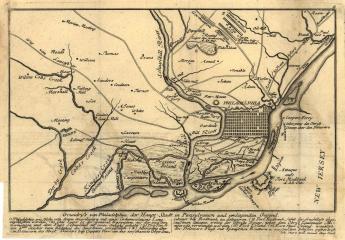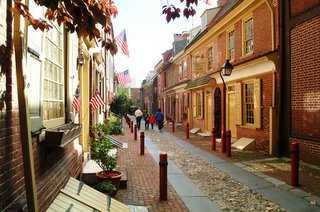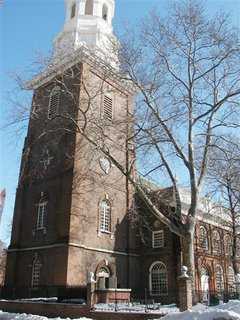Related Topics
Colonial Philadelphia (Pre- 1776)
 It's surprising to most Americans to learn the American Revolution was not the beginning, but almost half-way through the European settlement. And before the Revolution, there were thousands of years of settlement by non-European tribes. We know more about non-European settlers than we did fifty years ago, but records are still very poor or non-existent, and not likely to catch up very rapidly. History will begin in 1492 for a very long time. Long before that, it isn't history, it's anthropology.
It's surprising to most Americans to learn the American Revolution was not the beginning, but almost half-way through the European settlement. And before the Revolution, there were thousands of years of settlement by non-European tribes. We know more about non-European settlers than we did fifty years ago, but records are still very poor or non-existent, and not likely to catch up very rapidly. History will begin in 1492 for a very long time. Long before that, it isn't history, it's anthropology.
Religious Philadelphia
William Penn wanted a colony with religious freedom. A considerable number, if not the majority, of American religious denominations were founded in this city. The main misconception about religious Philadelphia is that it is Quaker-dominated. But the broader misconception is that it is not Quaker-dominated.
Historical Preservation
The 20% federal tax credit for historic preservation is said to have been the special pet of Senator Lugar of Indiana. Much of the recent transformation of Philadelphia's downtown is attributed to this incentive.
Particular Sights to See:Center City
Taxi drivers tell tourists that Center City is a "shining city on a hill". During the Industrial Era, the city almost urbanized out to the county line, and then retreated. Right now, the urban center is surrounded by a semi-deserted ring of former factories.
Tourist Walk in Olde Philadelphia
Colonial Philadelphia can be seen in a hard day's walk, if you stick to the center of town.
Arch Street: from Sixth to Second
When the large meeting house at Fourth and Arch was built, many Quakers moved their houses to the area. At that time, "North of Market" implied the Quaker region of town.
Christ Church and Elfreths Alley

|
| Elthreths Alley |
The north side of Dock Creek (now, Dock Street) was lower than Society Hillside and somewhat swampy. The tendency to flood caused the north side to have smaller and less permanent buildings, and so it became the Colonial waterfront area remaining more commercial, and in parts, shabby, even during the 19th Century. Still further to the north, this was not the case, but the waterfront and food market patch more or less marooned Christ Church, now the single most graceful and elegant Colonial building still standing. This formerly commercial area is now called Old City, with many loft apartments mixed among surviving warehouse outlets, and of course the ethnic restaurants characteristic of such gentrified areas.

|
| Christ Church |
Elfreth's Alley, running for one block east and west between Second and Front (1st) Streets. Some of the histories of this street is obscure, so some of it is probably synthetic because nothing particularly historic happened there to create detailed records. Elfreth's Alley claims to be the oldest street in America, a claim that can be substantiated back to 1702. The street is filled with little "workers houses", presenting a solid front of buildings on both sides of the cobblestoned street. Most of the houses could vaguely be called "father, son and holy ghost houses", looking as though they consisted of three rooms on top of each other, although in fact most of them are larger. A moment's consideration shows that the street consists of many double houses, with three doorways in front. Each house had a door to the interior, and most of them have a third door opening to a shared tunnel between the two houses, leading to the back yards. These tunnels were called "easements", a term that has migrated from its earlier usage. Although William Penn envisioned large single estates in his "Greene Country Towne", he sold considerable land to people who remained in England as absentee landlords, who soon found that many small houses produced more rent than one or two big ones. One of the houses on Elfreth's Alley acts as a museum, with tours; there is an active civic association, and once a year in June there is a street fair.
Because the land was swampy and the neighborhood congested, Christ Church soon outgrew its backyard burial ground, and burying important people under slabs in the walkways and corridors. Visitors who do not come from that sort of religious background are typically uncomfortable walking over such graves, a quite common arrangement in European cathedrals. But eventually, it was necessary to go several blocks westward to create a "new" burial ground. Most of the famous names from the Revolutionary era, like Benjamin Franklin and four other signers of the Declaration of Independence are found on the tombstones at Fifth and Arch, just across the street from the Free Quaker meeting house, and opposite the Philadelphia Mint. On the remaining corner of Fifth and Arch is the Constitution Center which will open July 4, 2003. It can already be seen that its architecture clashes with the rest of the historic area, but it is fervently hoped that its programs will redeem it.
REFERENCES
| Society Hill and Old City, Image of America: Robert Morris Skaler | Amazon |
Originally published: Monday, June 26, 2006; most-recently modified: Tuesday, April 30, 2019
| Posted by: Guylaine | Jul 27, 2015 4:21 PM |
| Posted by: followers exchange tool | Feb 13, 2012 9:47 AM |
| Posted by: cheapoair discount | Feb 13, 2012 9:26 AM |
| Posted by: esalerugs.com | Feb 13, 2012 9:04 AM |